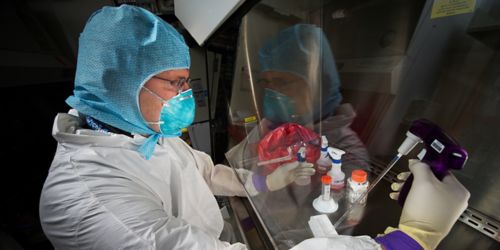St. Jude Family of Websites
Explore our cutting edge research, world-class patient care, career opportunities and more.
St. Jude Children's Research Hospital Home

- Fundraising
St. Jude Family of Websites
Explore our cutting edge research, world-class patient care, career opportunities and more.
St. Jude Children's Research Hospital Home

- Fundraising
Creating new therapeutic approaches for catastrophic pediatric diseases

A three-department collaboration created a new class of therapeutic compounds for children with metabolic diseases.
A collaboration with scientists from three departments at St. Jude created a new class of therapeutic compounds for children with metabolic diseases linked to mitochondrial function, called Pantazines.
Pantazines compounds may potentially extend the lives and ease the symptoms of sufferers of these disorders. The Pantazine development illustrates the drug discovery capabilities of the St. Jude Chemical Biology and Therapeutics Department (CBT).
Hope for sufferers of a rare disorder
Pantothenate kinase-associated neurodegeneration (PKAN) is an extremely rare, inherited disorder. About one to three per million individuals worldwide are diagnosed with PKAN, and most develop symptoms in childhood. PKAN leads to the accumulation of iron in brain cells and leads to difficulty walking, swallowing, chewing, and performing other activities. Current treatment primarily offers symptom relief.
PKAN occurs when neurons lack enough of a molecule called coenzyme A (CoA), which prevents the cells from functioning normally. Three closely related proteins PANK1-3, regulate CoA production in cells.
CoA is an essential molecule required for the growth of cells. Suzanne Jackowski, PhD, formerly of St. Jude Infectious Diseases, has studied CoA production for decades.
Forty years ago, she and Charles Rock, PhD, of Infectious Diseases, published the first evidence that an analogous enzyme in bacteria PanK was the pivotal regulator of CoA production.
Research in 2001 revealed that mutations in PANK2 were associated with PKAN. Based on this observation, Jackowski hypothesized that activating the alternative proteins PANK1 and PANK3 could make up for the CoA deficiency in PKAN patients.
Pantazines: Collaborating to find a treatment
Jackowski's theory led to the creation of an interdisciplinary project team coordinated by CBT project management group. In CBT, the High Throughput Bioscience team performed a high throughput screen of the CBT chemical library of over 500,000 compounds to identify novel modulators of PANK3. The hits from the screen were further analyzed by the Rock and Jackowski labs and synthetically optimized by the Lee lab in CBT, using a multiparameter drug design approach. The strategy enabled rapid development of ligands suitable for generating their X-ray crystal structures of pantazines bound to PANK3 by Dr. Stephen White's Lab in Structure Biology. The resulting structural information then enabled further optimization. The drug design strategy was critical for generating potent and selective candidates with good oral bioavailability that could also enter the brain, accelerating their preclinical evaluation.
Publications of our high-quality inhibitors and strong in vivo proof-of-concept data attracted the attention of a biotechnology company that licensed our Pantazine patent portfolio. They invested heavily in the program, accelerating progress, and recently obtained IND approval from the FDA to start clinical trials.
The approval marks the second time in the 15 years CBT has existed at St. Jude; we have advanced a new mechanism of action therapeutic into human trials. Both cases involved substantial chemistry efforts to generate and identify the most suitable compounds to take to the clinic.
Our goal is to bring chemistry to medicine and discover new therapeutic approaches for catastrophic pediatric diseases in CBT. It took many years, a lot of work, and close collaboration to make this happen. But, happily, it was an outstanding and rewarding team effort.





